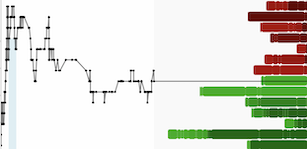TORONTO, Nov. 23, 2022 (GLOBE NEWSWIRE) -- Halcones Precious Metals Corp. (TSX – V: HPM) (the “Company” or “Halcones”) is pleased to announce assay results from the initial 2022 exploration program at its Carachapampa project (“Carachapampa” or the “Project”), Chile. Field mapping and rock sampling were carried out in September, towards the end of the South American winter and crews were successful in identifying well mineralized zones in outcrop at several locations on the Project.
Highlights include:
- A new highly prospective target area has been identified by the Company’s field program. Well mineralized and strongly silicified (vuggy quartz textured) structures have been discovered adjacent to a previously unidentified volcanic dome. Presence of volcanic domes are essential to development of the high sulfidation gold deposits in this region.
- At least four structures characterized by intense vuggy silica alteration were identified initially, with gold values in bedrock samples of 17.2 g/t Au, 8.93 g/t Au, 4.2 g/t Au, 3.6 g/t Au and 1.43 g/t Au. This sampling is based on limited exposure due to young volcanic cover in the area and as well was hampered by intermittent snow cover when work was done. More detailed mapping and sampling is in progress on this new target presently.
- The structures have been mapped for at least 600 metres along strike and across strike for more than 200 metres. Mapping is ongoing presently to identify additional structures as well as to look for windows where the rocks between the structures may be exposed through the cover of younger volcanics in the area.
- Drill hole 003 which was drilled previously appears to have collared on the side of the newly identified volcanic dome and intercepted 54 m grading 0.32 g/t Au including 20 m grading 0.56 g/t Au. This hole was drilled prior to the mapping and does not intersect the mineralized structures but is an indication of a highly anomalous and wide section of mineralization associated with the flank of the dome. The hole is approximately 1.5 km northeast from the mineralized samples.
- A second area approximately 1 km north and still on the flank of the dome returned samples with 2.5 g/t Au and 65 g/t Ag on highly silicified, vuggy quartz altered structures as well.
- One sample from the northeast target area which occurs approximately 2.8 km northwest of this new target area had a grade of 548 g/t Ag.
According to Vern Arseneau, COO of Halcones, “The initial field results are highly encouraging. Given the limited time the crews had in the field in the late winter, the discovery of the previously unmapped volcanic dome and associated vuggy silica alteration hosting significant gold mineralization over what appears to be an extensive area is an excellent outcome. Now that the weather has improved as Andean summer has commenced, the crews are back in the field to follow up on the initial discoveries with detailed sampling and mapping in preparation for drill testing in the coming months.”
Paul Pint, CEO of Halcones noted “We are just getting started with the work on this exciting Project, having only had the property for a few months and much of that time during Andean winter weather. It’s exciting to see the Project advancing at this early stage in the program.”
Carachapampa Project
The Carachapampa Project is located in the north-central part of the famous Maricunga Belt in Chile, approximately 180 km northeast of the city of Copiapo (Figure 1). The property is immediately adjacent to the past producing Nueva Esperanza Au-Ag mine and north of Kinross Gold’s La Coipa operations.
https://www.globenewswire.com/NewsRoom/AttachmentNg/7aa9c3de-b8fc-4a0e-96e3-3882a2170b59
Figure 1: Location map, Carachapampa Project in the Maricunga Belt.
The Carachapampa property is host to two prominent volcanic domes which are considered an essential component for development of high sulfidation gold deposits in this area (Figure 2). The forces that drive the magma to surface also drive large volumes of highly acidic fluids that are responsible for dissolving rock forming minerals near surface and creating the porous “vuggy quartz” alteration into which gold and silver mineralization is subsequently deposited (Figure 3).
https://www.globenewswire.com/NewsRoom/AttachmentNg/2527bc60-c4c6-4c4d-ba5d-11581b984a54
Figure 2: Photo mosaic showing the two large volcanic domes at Carachapampa. The property boundary is shown in red. A third smaller dome occurring between them was recently identified and appears to have significant gold mineralization associated with it.
https://www.globenewswire.com/NewsRoom/AttachmentNg/ba60c575-bd88-49f2-9b3e-260f640ced67
Figure 3: Conceptual geological model illustrating the relationship between volcanic domes and Au-Ag deposits in the area. Esperanza Dome is associated with the Arqueros and Chimberos gold mines located approximately 2 km west of the Carachapampa property.
During Halcones’ initial field program, geologists discovered a previously unidentified volcanic dome at the central part of the property and adjacent to that have discovered high grade mineralization in outcrops (Figure 4, 5, 6). Subsequent mapping and sampling has identified an extensive area on the west flank of the dome with strongly anomalous gold and locally high silver in numerous samples. This area is the focus for present field follow up with detailed mapping, sampling and targeted IP in preparation trenching and drilling in in the coming months.
https://www.globenewswire.com/NewsRoom/AttachmentNg/480d79b8-5818-4f1b-8486-9394491eb548
Figure 4: Map showing location of newly identified target area in the circle on the west side of the Carachapampa Project. The newly identified volcanic dome is enclosed in the dashed red line in the northeast quadrant. Anomalous gold samples in bedrock and sub outcrop are shown in red and yellow. Hole 003 referred to above is shown on the flank of the dome.
https://www.globenewswire.com/NewsRoom/AttachmentNg/1440b056-2ab3-4fc2-b782-956489158c29
Figure 5: At least four structures characterized by intense vuggy silica alteration and associated gold mineralization were mapped over approximately 600 metres of strike and across a width of approximately 200 metres. Detailed work is ongoing presently to attempt to expand on this potentially extensive mineralized area.
https://www.globenewswire.com/NewsRoom/AttachmentNg/e718f641-da6a-4816-a0a4-27ee882221ef
Figure 6: Anomalous silver values also occur, primarily in the northern part of the target area
Sampling Protocol
Sampling is conducted in a manner that will allow reasonable averaging and statistical analysis of the data for resource estimation. Standards, blanks and duplicate samples, are used to maintain quality control and to verify laboratory procedures. The company has established a QA/QC sampling control protocol which it applies to all rock sampling, including chip channels from trenches, surface grab samples and diamond drilling. Following is a summary of these protocols:
Drilling:
- Samples are collected using a standard 0.5 m to 1 m sample length in the main mineralized zones and a 1 m to 2 m length in the surrounding rocks or in other minor intervals of alteration and/or mineralization. Shorter sample lengths were avoided whenever was possible.
- Core samples are split along the core axis using an electric rock saw, by the Company’s trained technicians, prior to sampling the core is logged and a high-resolution photographic record is taken for the files.
- One standard sample is inserted for each 20 core samples and one coarse blank, one fine blank and one internal duplicate sample are included each 50 core samples for QA/QC control.
- In order to meet NI 43-101 security standards, the samples are placed in rice bags and sealed with numbered security tags on site and then shipped to the laboratory facilities by truck by Company personnel. The custody and transfer of samples is always the responsibility of Company personnel.
Surface and trenches:
- Channel trench samples are collected using a standard 0.5 m to 1 m sample length in the main mineralized zones and a 1 m to 2 m length in the surrounding rocks or in other minor intervals of alteration and/or mineralization. Shorter sample lengths are avoided whenever was possible.
- Field mapping samples are also collected using a standard 0.5 m to 1 m sample length in mineralized zones when possible, depending on the outcrop availability.
- One standard sample is inserted for each 20 core samples and one coarse blank, one fine blank and one internal duplicate sample are included each 50 samples for QA/QC control.
- In order to meet NI 43-101 security standards, the samples are placed in rice bags and sealed with numbered security tags on site and then shipped to the laboratory facilities by truck by Company personnel. The custody and transfer of samples is always the responsibility of Company personnel.
Laboratory Analysis
All analyses of the samples were carried out by ALS Limited, an independent laboratory with all regulatory documents and certifications approved and up to date. The sample prep facilities are based in Copiapo, 180 km SW from the project.
The analysis package chosen, for Au, Ag, and a multi-elements, trace level method are as follows:
Au-ICP21/Au-ICP22 – Fire Assay Fusion – ICP-AES Finish Sample Decomposition: Fire Assay Fusion (FA-FUSPG1 & FA-FUSPG2) Analytical Method: Inductively Couple Plasma – Atomic Emission Spectrometry A prepared sample is fused with a mixture of lead oxide, sodium carbonate, borax, silica and other reagents as required, inquarted with 6 mg of gold-free silver and then cupelled to yield a precious metal bead. The bead is digested in 0.5 mL dilute nitric acid in the microwave oven. 0.5 mL concentrated hydrochloric acid is then added and the bead is further digested in the microwave at a lower power setting. The digested solution is cooled, diluted to a total volume of 4 mL with de-mineralized water, and analyzed by inductively coupled plasma atomic emission spectrometry against matrix-matched standards.
When gold samples exceed the 10g/t upper detection limit of Au-ICP/Au-ICP methods, samples are re-assayed using the following:
Ag-GRA21, Ag-GRA22, Au-GRA21 and Au-GRA22 Precious Metals Gravimetric Analysis Methods Sample Decomposition: Fire Assay Fusion (FA-FUSAG1, FA-FUSAG2, FA-FUSGV1 and FA-FUSGV2) Analytical Method: Gravimetric A prepared sample is fused with a mixture of lead oxide, sodium carbonate, borax, silica and other reagents in order to produce a lead button. The lead button containing the precious metals is cupelled to remove the lead. The remaining gold and silver bead is parted in dilute nitric acid, annealed and weighed as gold. Silver, if requested, is then determined by the difference in weights.
Qualified Person
The scientific and technical information in this news release has been reviewed and approved by Mr. David Gower, P.Geo., as defined by National Instrument 43-101 of the Canadian Securities Administrators.
About Halcones
Halcones Precious Metals Corp. is focused on exploring for and developing gold-silver projects in the Maricunga Belt, Chile, the premiere gold mining district in South America. The Company has a team with a strong background of exploration success in the region.
For further information, please contact:
Vincent Chen
Investor Relations
info@halconespreciousmetals.com
www.halconespreciousmetals.com
Cautionary Note Regarding Forward-looking Information
This press release contains “forward-looking information” within the meaning of applicable Canadian securities legislation. Forward-looking information includes, without limitation, regarding the prospectivity of the Project, the mineralization of the Project, the Company’s exploration program, the Company’s ability to explore and develop the Project and the Company’s future plans. Generally, forward-looking information can be identified by the use of forward-looking terminology such as “plans”, “expects” or “does not expect”, “is expected”, “budget”, “scheduled”, “estimates”, “forecasts”, “intends”, “anticipates” or “does not anticipate”, or “believes”, or variations of such words and phrases or state that certain actions, events or results “may”, “could”, “would”, “might” or “will be taken”, “occur” or “be achieved”. Forward- looking information is subject to known and unknown risks, uncertainties and other factors that may cause the actual results, level of activity, performance or achievements of Halcones, as the case may be, to be materially different from those expressed or implied by such forward-looking information, including but not limited to: general business, economic, competitive, geopolitical and social uncertainties; the actual results of current exploration activities; risks associated with operation in foreign jurisdictions; ability to successfully integrate the purchased properties; foreign operations risks; and other risks inherent in the mining industry. Although Halcones has attempted to identify important factors that could cause actual results to differ materially from those contained in forward-looking information, there may be other factors that cause results not to be as anticipated, estimated or intended. There can be no assurance that such information will prove to be accurate, as actual results and future events could differ materially from those anticipated in such statements. Accordingly, readers should not place undue reliance on forward-looking information. Halcones does not undertake to update any forward-looking information, except in accordance with applicable securities laws.
NEITHER TSX VENTURE EXCHANGE NOR ITS REGULATION SERVICES PROVIDER (AS THAT TERM IS DEFINED IN THE POLICIES OF THE TSX VENTURE EXCHANGE) ACCEPTS RESPONSIBILITY FOR THE ADEQUACY OR ACCURACY OF THIS RELEASE.












